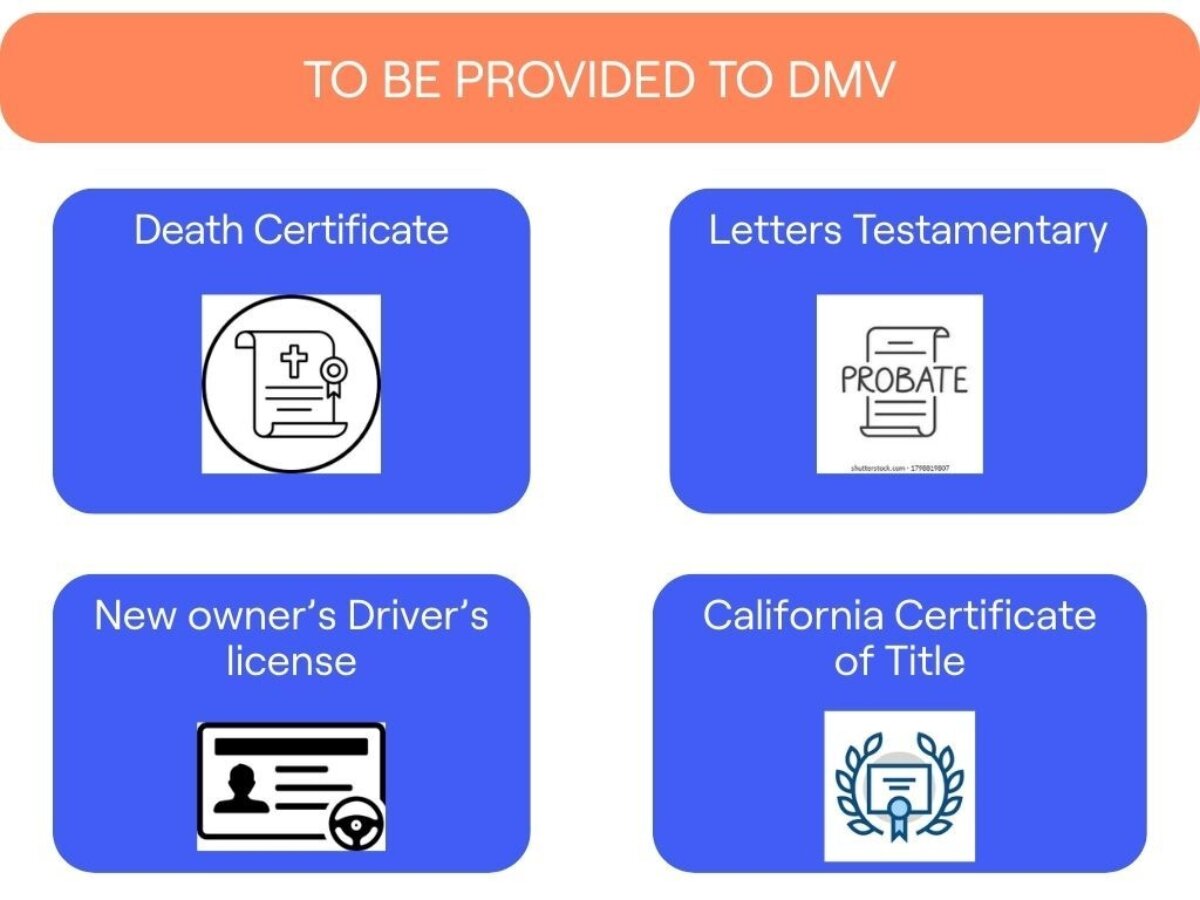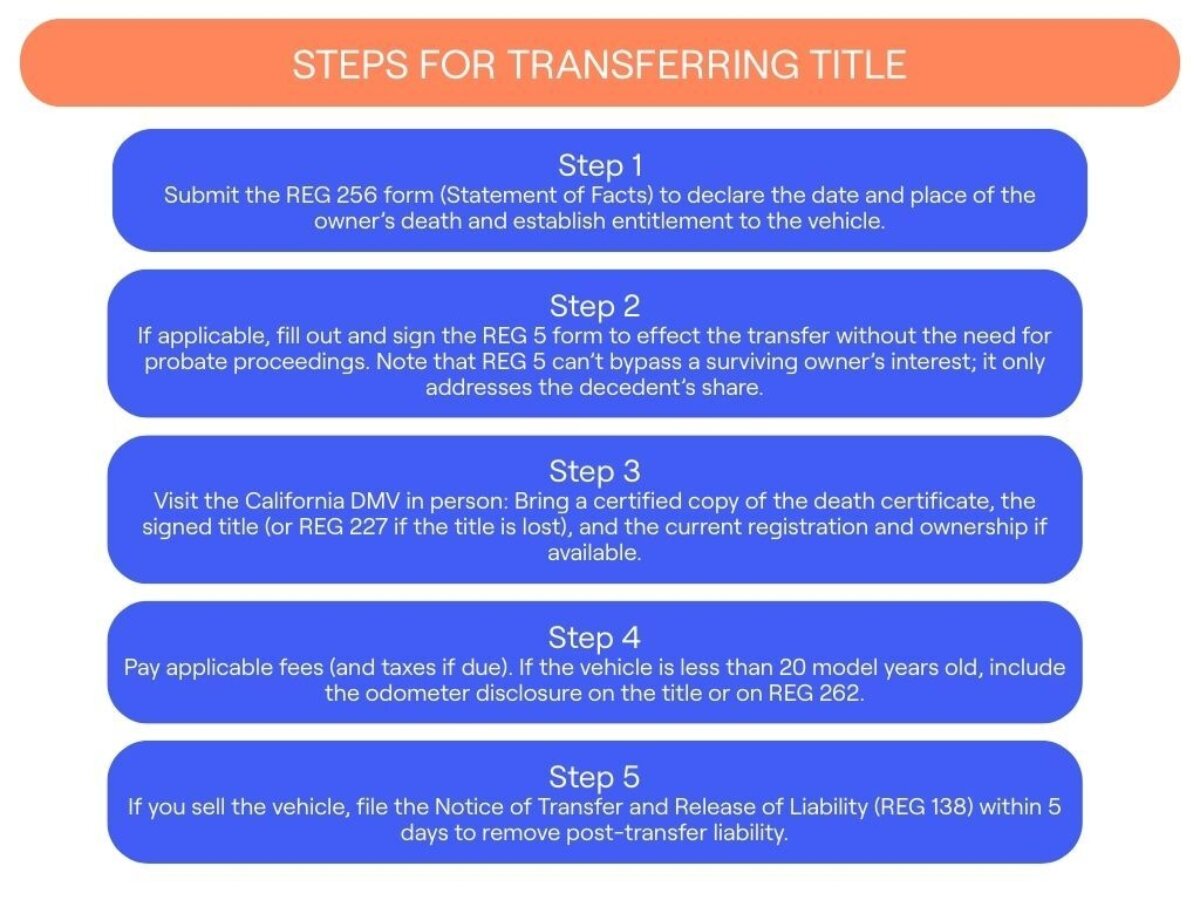Estate Settlement
May 01, 2025
What to Do When Someone Dies in California
Follow this step-by-step guide to navigate legal duties, probate, and estate tasks with clarity and confidence.
As an executor, you're responsible for distributing estate assets, including vehicles. Here is how you transfer the car title of the deceased in California.


Article Contents
When a loved one passes away, the named executor or administrator will be responsible for carrying out the wishes of the deceased as per their will. One of these such wishes may include transferring the deceased’s car title to a beneficiary or selling it.
In California, there are specific steps that must be taken in order to legally transfer a car title after someone has died. Here is an overview of what you need to know depending on which situation you find yourself in. Generally speaking, there are three scenarios you should be aware of: transferring title within probate, transferring title outside of probate and transferring title as a trustee.
Let’s review all three situations below, starting with transferring title within probate.
Assuming that you have already filed a formal probate application with the court, you will find transferring ownership of one or more automobiles to be an easy process. Just as you would with other probate assets, you will be required by the court to formally transfer automobiles to the person designated in the deceased’s Will. Here is an outline of the basic steps.
California’s DMV (Department of Motor Vehicles) will require a number of documents in order for title to be transferred. These include:
A copy of the Letters Testamentary (or Letters Administration, where applicable)
A copy of the decedent’s death certificate
Driver's license of the decedent
The California Certificate of Title for the vehicle
If the Certificate of Title is missing, the executor/administrator will need to fill out and sign form REG 227 (Application for Replacement or Transfer of Title).
California’s DMV does not have a form for transferring a vehicle within probate. However, the DMV does require relevant sections of form REG 256 (Statement of Facts) to be completed to transfer ownership.
For any ownership transfers on or after January 1, 2021, an odometer disclosure is required for vehicles less than 20 model years old. The disclosure can be made either on the Certificate of Title (if it has a disclosure section) or on the DMV’s REG 262 form.
Once all the required documents have been submitted to the DMV, the executor must pay the appropriate fees and taxes. Additionally, the registration of the vehicle may need to be renewed at this time.
At this point, the title of the vehicle will now be in the name of the executor/administrator. If the executor chooses to sell the vehicle in accordance with the will, the process is largely straightforward. Otherwise, the executor/administrator can continue to transfer the title to the designated beneficiary(ies) as part of the probate process.
To ensure simplicity in this process, the personal representative signs the title paper (pink slip) by signing the deceased’s name, followed by his/her actual name, and “Executor”.
By giving a copy of the Letters Testamentary (or Letters of Administration) to the buyer, the new owner will be able to register the vehicle with the DMV. Monies exchanged should be deposited into the estate’s bank account. It is also a good idea for the new vehicle owner to have a copy of the decedent’s death certificate, as this may be requested by the DMV staff member handling the transfer.

As the transfer of a personal vehicle after death of the owner being most common without probate in the State of California, the DMV provides a simple process for executors. Below are general steps you can follow.
Forty days must have passed since the vehicle owner’s passing.
During this time gather the required documents, which include an original death certified (or certified copy), the California Certificate of Title and a copy of the will of the decedent.
If the vehicle was owned by two or more decedents (i.e. husband and wife who have both died) original or certified copies of both death certificates, and a completed REG 5 form for the most recent decedent, must be submitted.
The uncomplicated REG 5 form (Affidavit for Transfer Without Probate) will transfer the vehicle in question from the estate of the deceased to a relative, or specified beneficiary in the Will. The new owner can then decide whether to keep the vehicle, sell it, or perhaps trade it for something different.
The REG 5 must be completed by one of the following:
The person or persons specifically designated in the decedent’s will to take ownership of the property upon death.
The guardian or conservator who succeeded to take control of the decedent’s property under death.
A beneficiary specified in the decedent’s will to take possession of the vehicle after his/her passing.
A designated Trustee appointed by the decedent prior to death.
In order for a vehicle to be transferred to a new owner without probate, the vehicle must be titled in California. If it’s titled in another state, handle the transfer under that state’s rules before bringing it into California. It’s important to note that states may not have the same vehicle transfer requirements as in the decedent’s home state.
Note that if the vehicle was owned by two or more persons, but only one of the two is deceased, the REG 5 form cannot bypass a surviving owner’s interest. If one owner survives, that person signs the title as the owner. If the survivor also wishes to release the decedent’s interest, submit REG 5 for the decedent’s share.
Important: The REG 5 form cannot be used if the value of the estate exceeds certain limits. If the owner(s) passed away prior to March 31, 2025, the value of their estate must be less than $184,500. If the owner(s) passed after April 1, 2025, the value of their estate must not exceed $208,850 to be eligible for a transfer using REG 5. However, the value of the vehicle to be transferred is not included in this threshold calculation. Additionally, California law allows the transfer of a vehicle “irrespective” of its value, so long as there is no other property that necessitates probate*.
*Note: Under the California Probate Code, the value of the vehicle(s) being transferred is specifically excluded from this threshold calculation. This means vehicles do not count toward the estate value limit. Additionally, California law allows the transfer of a vehicle "irrespective" of its value, as long as there is no other property that requires probate.
The DMV provides the REG 5 form to make vehicle transfer without probate easier.
This form is only for estates that do not exceed $208,850 in personal and real property (not including the value of the vehicle), as of April 1, 2025.
This form is only available to use if 40 days have elapsed since the date of death.
After DMV receives a complete submission, standard processing is typically ~8–10 business days; online submissions are currently estimated at around 4 weeks. Rush title service (extra fee) is processed within 72 hours.
Surviving spouses or domestic partners in California may face different procedures based on how the vehicle was titled. Understanding the specifics can significantly simplify the transfer process. We discuss these specifics below.
If the vehicle was only in the decedent’s name, the surviving spouse may need court involvement to transfer the vehicle. However, check first for simpler DMV paths that may apply (e.g., REG 5 – Affidavit for Transfer Without Probate). If other assets require a Spousal or Domestic Partner Property Petition, it may be efficient to include the vehicle there as well.
In California, there are two different ways a vehicle title may list joint owners. Depending on how the title shows ownership could decide whether the transfer needs to be subject to probate proceedings.
Names joined by “or/and-or” (often survivorship): Typically, the surviving co-owner can transfer the vehicle without probate by signing the title and providing a copy of the death certificate.
Names joined by “and,” or titles marked Tenants in Common: The decedent’s share doesn’t pass automatically. The surviving owner signs, and the decedent’s interest is cleared either with REG 5 (if eligible) or by a personal representative with court Letters. Probate may be required if REG 5 isn’t available.
For vehicles registered in TOD or JTRS forms, the designated beneficiary (often the surviving spouse) inherits the vehicle without the need for probate. This registration simplifies the process considerably. We outline the process below.

A trust is established to hold and manage property and assets for an individual, couple, or family, often in the event of incapacity or death of one or more trustors. When a vehicle is owned by a trust, typically the trustee can transfer title without the need for probate.
If the vehicle is being transferred out of the trust, all trustees whose names appear on the title must sign to release the interest. If no trustee names appear on the title, the DMV requires at least one trustee to sign and submit a Statement of Facts (REG 256, Section G) attesting to their appointment as trustee or successor trustee.
After all required forms are correctly completed and submitted, and the appropriate fees paid, the DMV generally processes the title transfer within 8 to 10 business days.
 Simplify Probate Today
Simplify Probate Today
Get expert guidance from our specialists who've helped 10,000+ families.
Book a free consultation